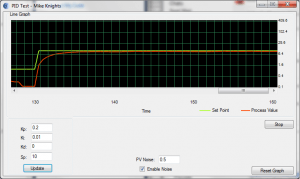Since the last post, The motors have been replaced. I have spent a lot of time trying to get the quadcopter to level nicely, however I’m still getting a lot of osculations and the system is still not complete. I have attempted to use the accelerometer from the multiwii board instead of the sonar alone and found it to be quite smooth. However due to time constants I have been unable to fully integrate it to the auto-level part of the program.
I have however managed to write code for an automated landing. The uses the accelerometer to gently lower the craft until it is close to ground, at this point it starts lowing the throttle until the value is lower then a preset value and turns the craft off. At this point the craft is always on or very close to ground.
Unfortunately I very much doubt I will be able to dedicate any more time to this project for the time being, as I now have to finish up the documentation for this project as well as other paper based work for other modules for my course. However I will likely continue this further after the final write up is handed in and will definitely will be posting again before the conclusion of my degree.
You can also follow my personal blog Here
